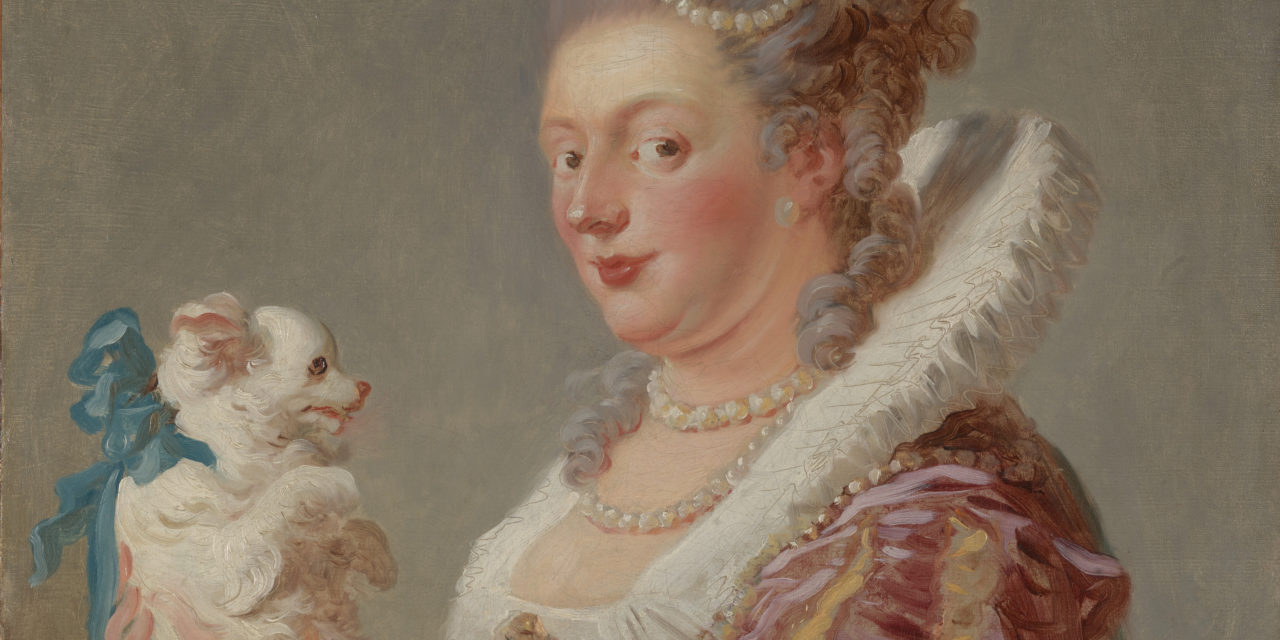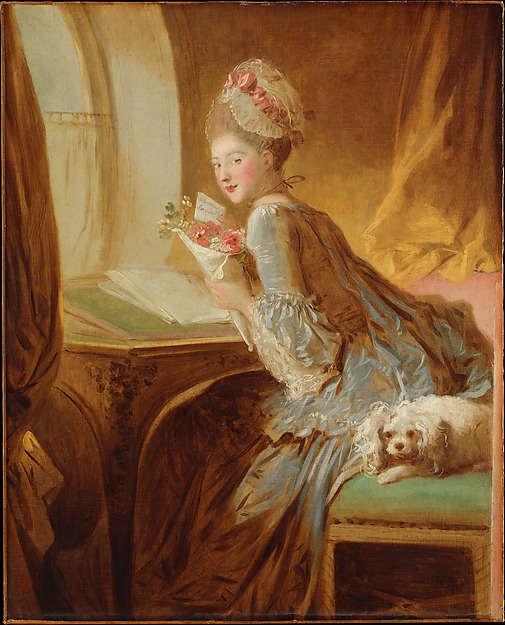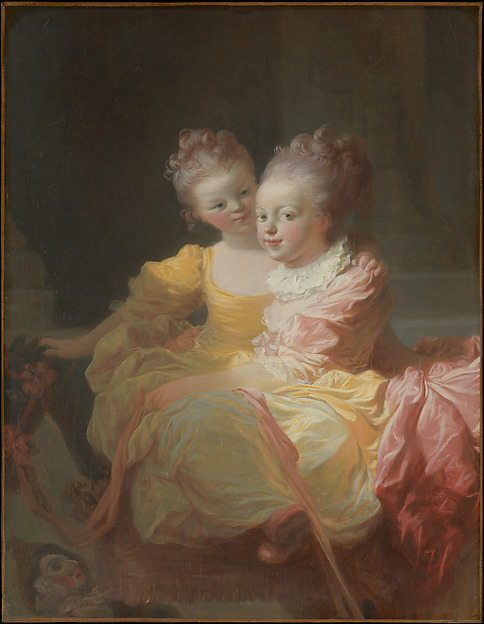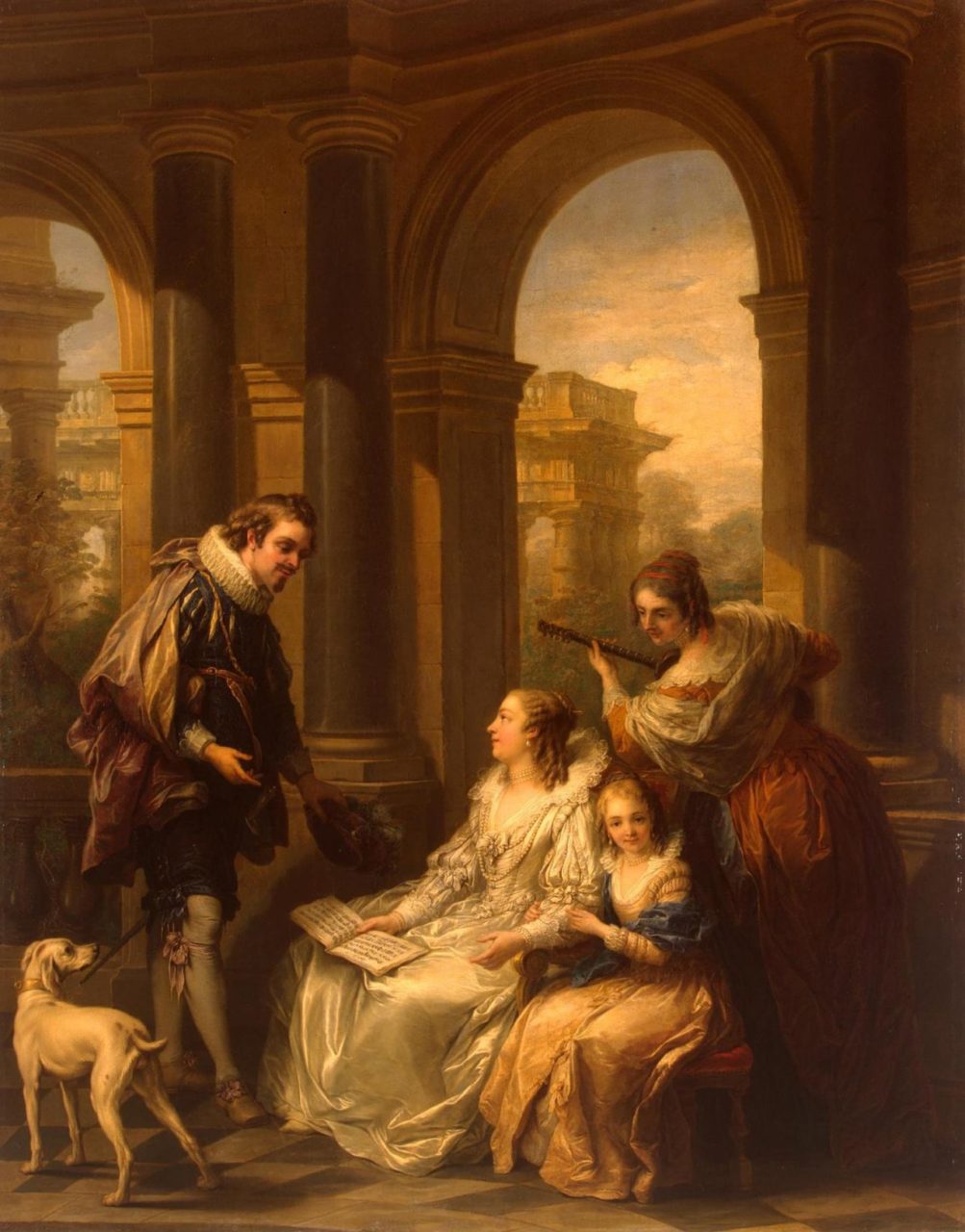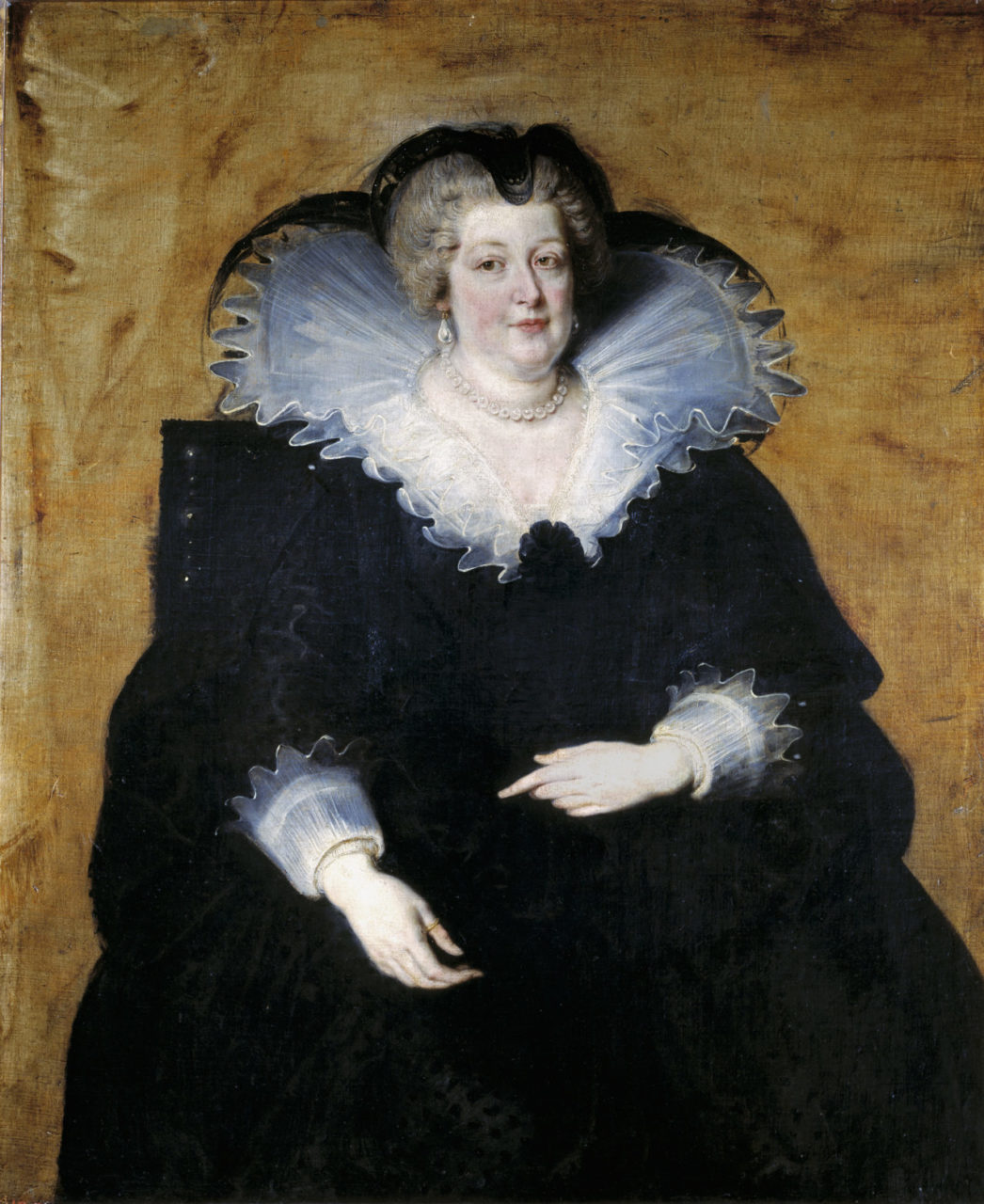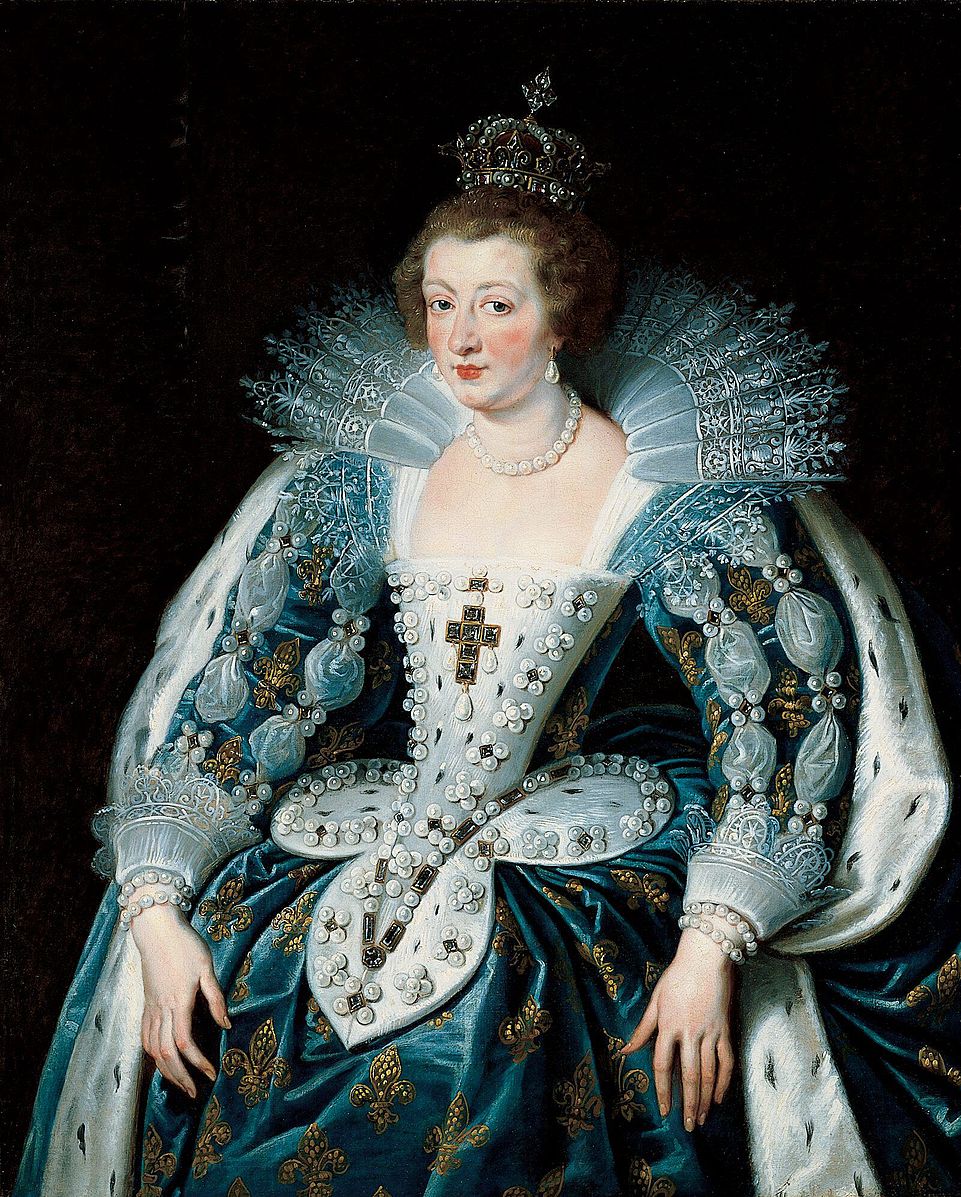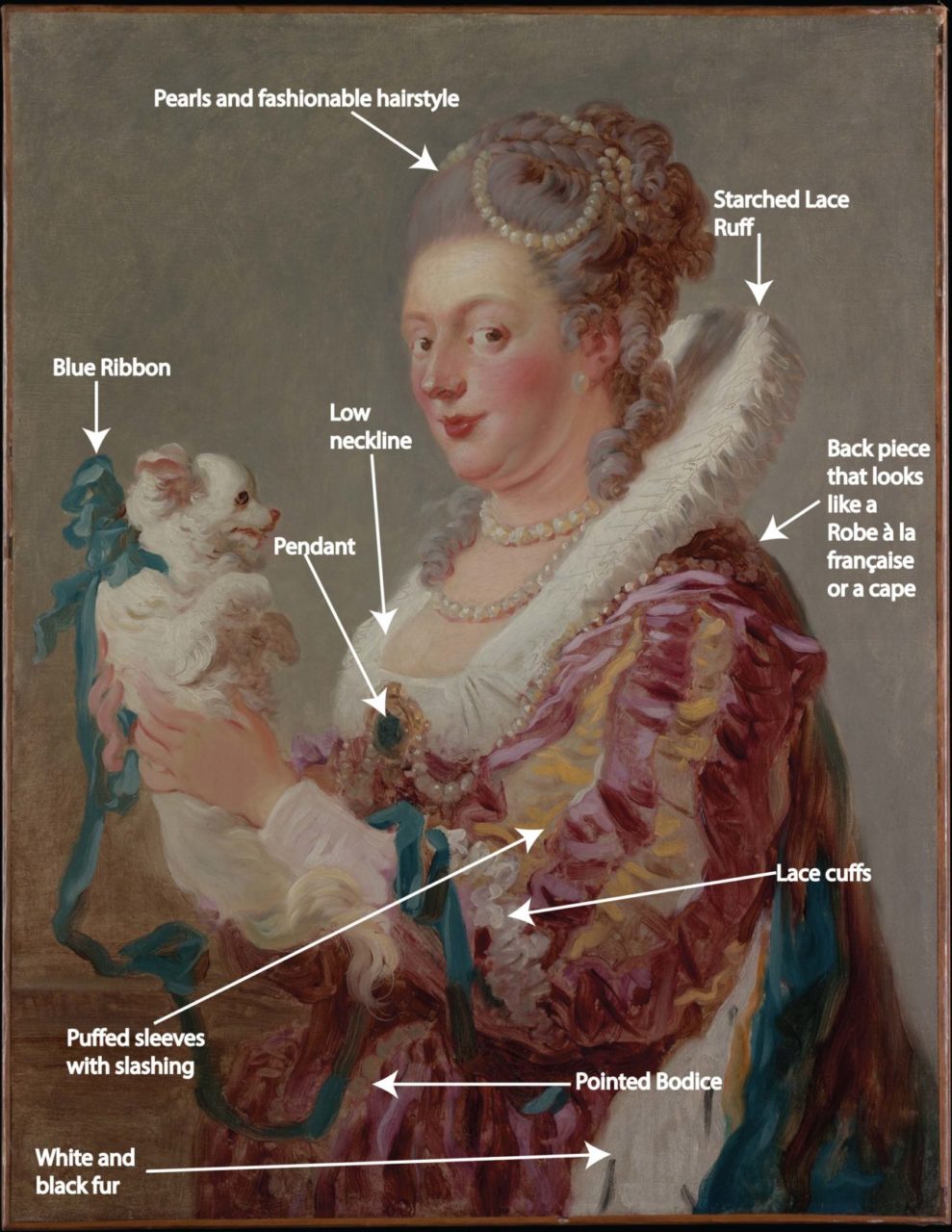Jean-Honoré Fragonard portrays a sitter holding a lapdog, wearing what he may have considered Spanish costume, but is actually a fanciful take on historical fashions of the early 17th century.
About the Artwork
Jean-Honoré Fragonard was one of the last artists of the Rococo time period. Born in the Provencal city of Grasse on April 5, 1732, he moved to Paris with his family at a young age. His excellent drawing skills were quickly noted by employers as well as by Rococo painters Chardin and Boucher, under both of whom he studied. He won the Prix de Rome in 1752 (Williams Jr. 14) and went to Italy to study at the Royal Academy of Painting and Sculpture in 1765 (Harrison).
Known for his charm and wit, Fragonard became one of the most productive painters during his time. He also became known for his fanciful erotic scenes exemplified in one of his most famous paintings, The Swing, at the Wallace Collection in London. His signature style consists of carefree subject matters, broad brush strokes, and soft pastel colors (Thuillier 14).
A Woman with a Dog was also painted during his intermediate years and it is part of a series referred to collectively as the Figures de Fantaise (Fantasy Figures) collection. These paintings were done within an hour and were frequently misjudged because of the level of execution. Painters who painted these were known as a “virtuoso of speed” (Thuillier 118; Cuzin 102).
In the painting, the model was recently identified to be Marie Emilie Coignet de Courson (1727-1806). For a long time, the sitter was wrongly identified as Fragonard’s sister or aunt. Some believe that the sitter was an actress or singer because of her dress and rows of pearls. He did a quick study of her, sketched a life-size draft and painted it in one sitting. Little is known on whether or not this was commissioned. However, Madame de Pompadour sponsored the painting of figures in an effort to move away from the previous more serious subject matters. She suggested that artists paint people wearing different European dress (Williams Jr. 15).
His painting process is unique in the sense that he has quick, thin brush strokes everywhere except the face. The face is modeled and painted carefully. His speed can be seen in the clothing–bold brush strokes painted quickly, but accurately. Close analysis shows that for the sleeve, he first laid down the red and yellow, followed by stronger accents for shadows and mixed those colors with white for lightness. The final step was using absolute white for highlights (Williams Jr. 16). A similar painting style can be seen in his paintings The Love Letter (Fig. 1) and The Two Sisters (Fig. 2). Both paintings have more details in the face than the clothing and similar brushwork can be seen in the clothing.
Fig. 1 - Jean Honoré Fragonard (French, 1732–1806). The Love Letter, early 1770s. Oil on canvas; 83.2 x 67 cm (32 3/4 x 26 3/8 in). The Jules Bache Collection, 1949: The Metropolitan Museum of Art, 49.7.49. The Jules Bache Collection, 1949. Source: The Metropolitan Museum of Art
Fig. 2 - Jean Honoré Fragonard (French, 1732–1806). The Two Sisters, ca. 1769–70. Oil on canvas; 71.8 x 55.9 cm (28 1/4 x 22 in). New York: The Metropolitan Museum of Art, 53.61.5. Gift of Julia A. Berwind, 1953. Source: The Metropolitan Museum of Art
Jean-Honoré Fragonard (French, 1732-1806). A Woman with a Dog, 1769. Oil on canvas; 81.3 x 65.4 cm (32 x 25 3/4 in). New York: The Metropolitan Museum of Art, 1937. 37.118. Fletcher Fund. Source: The Met
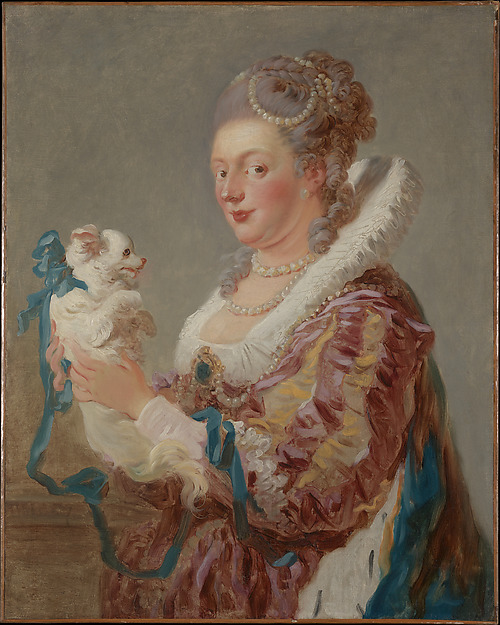
About the Fashion
The sitter is seen wearing what looks like a pink silk dress, starched lace ruff, paned leg-of-mutton sleeves that reveal the white/ yellow sleeves underneath, and lace cuffs. The back of the gown has also some white and black details which bear a resemblance to ermine fur, implying a fur-lined cape. However, the front of the gown reveals a pointed bodice and low neckline like that of the early 17th century as well as the starched ruff or Medici collar, which was one of the most distinctive garments of the early 17th century.
The style of dress depicted would not be considered fashionable during the 18th century Rococo period. Georges Wildenstein argues that Fragonard thought he was painting Spanish-style dress because his master at the time, Carle Van Loo, featured similar style dress in his Spanish Conversation (Fig. 3) (Fragonard 14-15). Some say that Fragonard painted the sitter wearing this dress because of Madame de Pompadour’s sponsorship (Williams Jr. 15). The style of the dress is early 17th century, but the pink and blue colors and hairstyle are pure Rococo. An example of fashionable 18th-century powdered hair can be seen in a portrait of Madame de Saint-Maurice (Fig. 4) by Joseph Siffred Duplessis painted a few years after Fragonard’s A Woman With a Dog.
The Rococo style consisted of light, airy, soft details; lace collars were softer, colors were lighter, and details such as ribbons and bows on the stomacher were popular. Madame de Pompadour (Fig. 5) exemplifies 18th-century high fashion in François Boucher’s portrait of her from 1756.
Fig. 3 - Carle Van Loo (French, 1705-1765). Spanish Concert (Spanish Сonversation), 1754. Oil on canvas; 164 x 129 cm. St. Petersburg: The Hermitage, ГЭ-2173. Entered the Hermitage in 1772; acquired from the collection of M.T. Joffrin in Paris. Source: Hermitage
Fig. 4 - Joseph Siffred Duplessis (French, 1725–1802). Madame de Saint-Maurice, 1776. Oil on canvas; 100.3 x 81 cm (39 1/2 x 31 7/8 in). New York: The Metropolitan Museum of Art, 69.161. Bequest of James A. Aborn, 1968. Source: The Metropolitan Museum of Art
Fig. 5 - François Boucher (French, 1703-1770). Portrait of Madame de Pompadour, 1756. Oil on canvas; 201 x 157 cm (80 × 62 in). Munich: Alte Pinakothek, Inv. Nr. HUW 18. Dauerleihgabe der HypoVereinsbank, Member of UniCredit. Source: Alte Pinakothek
Fig. 6 - Peter Paul Rubens (Flemish, 1577-1640). Marie de Médicis, ca. 1622. 51.2 x 42.5 in; 130 x 108 cm (51.2 x 42.5 in). Madrid: Museo del Prado, P001685. Source: Museo del Prado
Fig. 7 - Peter Paul Rubens (Flemish, 1577-1640). Portrait of Anne of Austria, Queen of France, ca. 1622-25. Oil on canvas; 120 x 96.8 cm (47-1/4 x 38-1/8 in). Pasadena: Norton-Simon Museum, F.1965.1.059.P. Source: Norton Simon
Pearls were popular accessories during the Rococo period. The sitter has rows of pearls around her neck, on her hair, and also on her bodice, where a brooch is attached to a string of pearls that continues around her back. She is holding a small white dog with blue ribbon attached to it. There is a humorous juxtaposition between the small size of the lapdog and the sitter’s grand costume. Because of her size, some compare the painting to Peter Paul Rubens’s paintings of Marie de Médici (Fig. 6) (Baetjer). A closer 17th-century portrait by Rubens is that of Anne of Austria, Queen of France, from 1622-25 (Fig. 7), which shares the Medici collar, slashed leg-of-mutton sleeves and ermine-lined cape.
Since this dress is a 16th/17th-century style dress, it is possible that the model was an actress or singer, so this costume would be worn during her performances. The costume is lavish with lace, pearls and a jeweled brooch, implying that the woman was of a higher social status.
References:
- Baetjer, Katharine. “Jean Honoré Fragonard | A Woman with a Dog | The Met.” The Metropolitan Museum of Art. Accessed May 16, 2018. https://www.metmuseum.org/art/collection/search/436323.
- Cuzin, Jean Pierre. Fragonard Life and Work: Complete Catalogue of the Oil Paintings. New York: Abrams, 1988. http://www.worldcat.org/oclc/911637809.
- Harrison, Colin, and Marie-Claude Chaudonneret. “Fragonard family.” Grove Art Online. 16 May. 2018. http://www.oxfordartonline.com/groveart/view/10.1093/gao/9781884446054.001.0001/oao-9781884446054-e-7000029177.
- Thuillier, Jacques, and Albert Châtelet. French Painting, from Le Nain to Fragonard. Geneva: Skira, 1964. http://www.worldcat.org/oclc/542705.
- Wildenstein, Georges. The Paintings of Fragonard. London: Phaidon, 1960. http://www.worldcat.org/oclc/984079298.
- Williams, Hermann W. “Portrait of a Lady with a Dog by Fragonard.” The Metropolitan Museum of Art Bulletin 33, no. 1 (1938): 14-16. http://www.jstor.org/stable/3256615.

